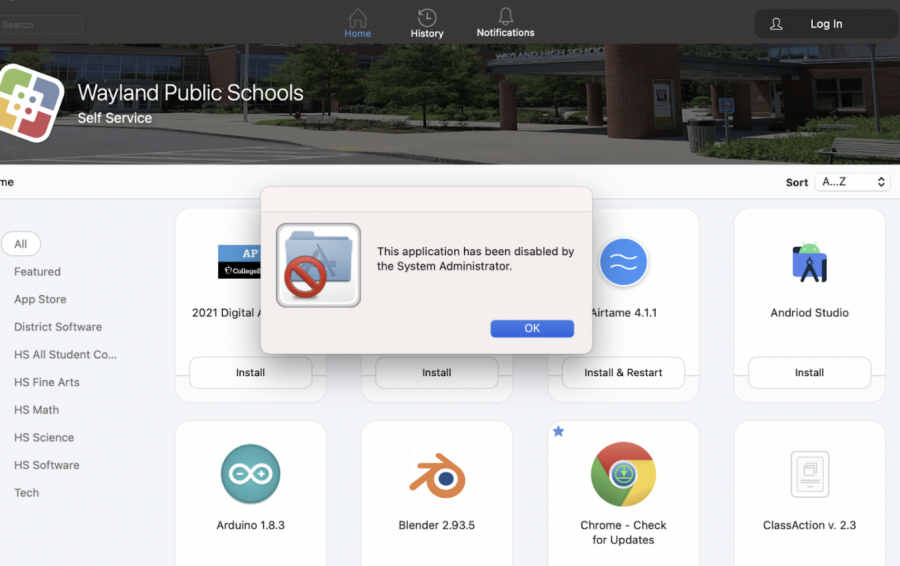Crushing Creativity: WHS computer limitations do more harm than good
Credit: Jonathan Zhang
WSPN’s Jonathan Zhang and Brasen Chi share their reasons for why computer limitations can actually end up doing more harm than good.
November 13, 2021
It’s like I’m a member of an orchestral performance. The resonation of my peers’ minds working to transpose another creative idea, from their imagination, to their computers all around me. The call and response of the soft clicking of keys and hesitations caused by hovering fingers trying to connect one thought to the next lets you hear ideas coming to life. Yet, in the midst of this creative environment, some sit, instruments nowhere to be found.
I am one such student without an instrument. I’ve been told that I can’t play. Not because of my ability or any past repercussions, but rather, I’ve been stopped purely based on the off-chance that I misplay and cause a disruption. And so, I sit, listening and watching while suppressing my desire to join in.
Such is the problem that Honors Applied Computer Science (HACS) students face at Wayland High School. While my peers explore the depths of computer science and take advantage of its infinite potential to construct anything that their minds desire, I remain limited by the very institution that was supposed to inspire my creativity.
What was this terrible thing that WHS prevents me from working on? With dozens of portals, numerous due dates and countless essays to keep track of, I started to feel overwhelmed.
I decided to create a website tailored to suit my needs and help me stay on top of things during the college admissions process. With the tutorial before me and excitement bubbling up inside me, I was ready. All that was left was to download some basic software for me to get started on my journey. I smiled, and I clicked the download button.
The nine words displayed on the tab that popped up would become the source of both my classmates’ and my frustration for days to come: “This application has been disabled by the System Administrator.”
What was I to do? Sure, I could change my idea or the software that I was using. But, I had already found the perfect tutorial that modeled for me the exact component that I wanted to implement on my own website.
Some of the students in my class have come up with detours around the dilemma, they brainstorm in class and work on their projects at home on their personal computer.
Not only is this impractical, but many students like myself either don’t have computers advanced enough to run the needed programs or don’t even have a personal computer at all.
While I’d like to limit my frustration to the inability to download necessary applications to create the projects I desire, it’s not that simple. The restrictions on student computers also affect my everyday life in little ways.
For example, I now have to sit through ads on YouTube whenever I want to listen to a playlist or watch educational videos to study for tests. Whereas, in the past, I could have just installed AdBlock from the Chrome Web Store in a matter of seconds. Have you any idea how frustrating it is to sit there waiting for that Skip Ad button the night before a big exam?
Now, I understand that these computer limitations are meant to prevent students from misusing their computers in a way that diverts their attention from their studies. However, students are and will constantly find ways to get around these limitations. Technology is constantly changing and developing, and along with it, student’s innovation to step around the obstacles set before them.
I’m not saying unrestricted freedom to the full capabilities of our computers is a good thing, nor do I have a solution that goes beyond granting all computer science students administrator privileges over their computers. All I’m saying is that not only does the current status quo does restrict students from accessing some educationally disruptive applications, it also crushes students’ creativity.





![Last Wednesday, the Wayland School Committee gathered to discuss a number of topics regarding the health curriculum and Innovation Career Pathway course. Another large topic of conversation was the ways to potentially mitigate distracting cell phone usage. "These [phones] are going to distract your learning and social relationships," Superintendent David Fleishman said. "That's concrete right there."](https://waylandstudentpress.com/wp-content/uploads/2025/06/Screenshot-2025-06-04-at-9.49.31 PM-1200x886.png)



























![Troy Hoyt finishes the Boston Marathon, running for the Hoyt Foundation. T. Hoyt is the son of Hoyt Foundation CEO Russ Hoyt.
“[Running a marathon] might seem like a big thing, when it’s presented to you at first, but if you break it up and just keep telling yourself, “Yes, you can,” you can start chipping away at it. And before you know it, you’ll be running the whole 26 miles, and you won’t even think twice about it.” T. Hoyt said.](https://waylandstudentpress.com/wp-content/uploads/2025/04/C36E8761-1CBB-452E-9DF2-543EF7B1095E_1_105_c.jpeg)














































